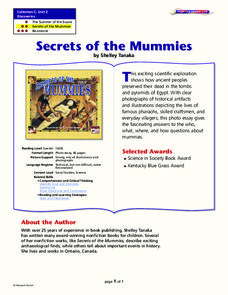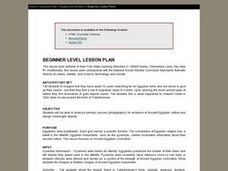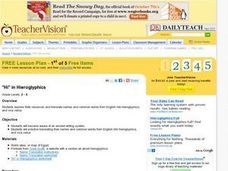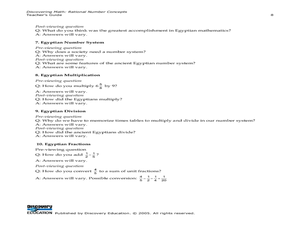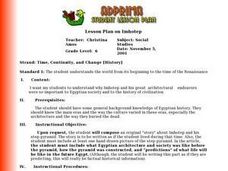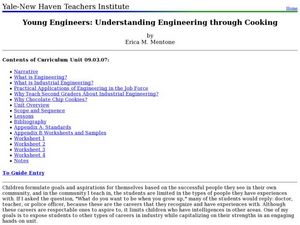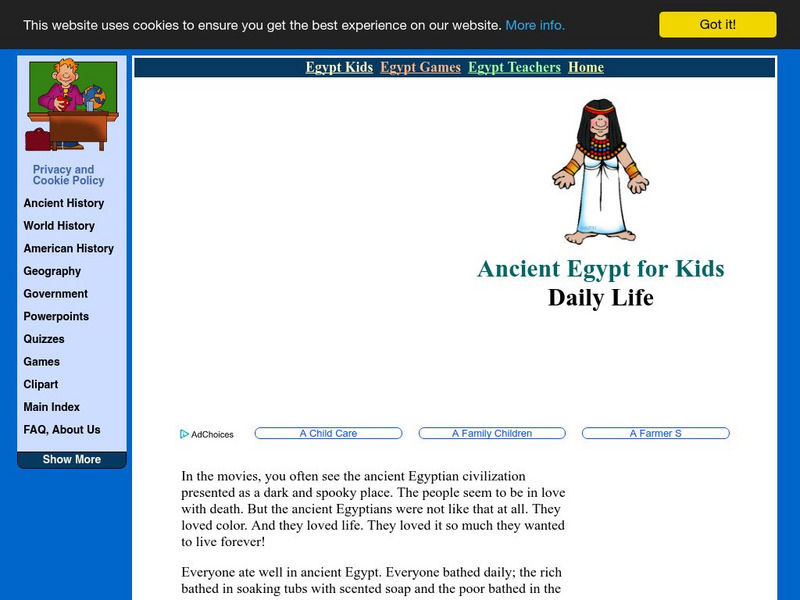EngageNY
Trigonometry and the Pythagorean Theorem
Ancient Egyptians sure knew their trigonometry! Pupils learn how the pyramid architects applied right triangle trigonometry. When comparing the Pythagorean theorem to the trigonometric ratios, they learn an important connection that...
Curated OER
Building the Pyramids: No Light Task
Eighth graders perform experiments with simple machines and write up the results. They research the construction of the step pyramid and the three pyramids at Giza. Students research how the ancient Egyptians used simple machines in...
Curated OER
Egyptian Tomb Art: Expressions of Religious Beliefs
Ninth graders are introduced to the Prown's technique of describing various objects. As a class, they view pictures of the pyramids in Egypt and discuss how the size and shape of them show their belief in eternal life and religion. ...
Curated OER
Balancing Equations and Using a Pyramid
Sixth graders complete worksheets and make journal entries to interpret mathematical expressions about the pyramids. In this equality by balancing equations lesson, 6th graders participate in groups or by themselves to complete exercises...
Curated OER
Discovering Math Rational Number Concepts
Students research Egyptian hieroglyphics using print and Web resources. THey discuss Egyptian achievements in mathematics. Students explore how Egyptians used hieroglyphics to write numerals. They multiply and divide numbers using the...
Curated OER
Egyptian Antiquities
Students recognize that ancient builders overcame great obstacles in erecting monuments. They research the history and the status of conservation efforts over the course of the last 20 to 30 years to answer provided questions.
Curated OER
Secrets of the Mummies
How did the ancient people of Egypt preserve their dead so well that their bodies are still recognizable today? Learn the painstakingly complex process they used for preservation. Young scholars read and summarize a narrative detailing...
Curated OER
Egyptian Expedition
Students identify and analyze ancient Egypt and interpret how to develop bibliographical references. They research topics using multiple resources and various forms of media of media. Finally, students practice and deliver an oral...
Curated OER
Shapes and Shelters
Students are be able to analyze primary sources (photographs) for evidence of Ancient Egyptian culture and design meaningful objects. They are grouped in pairs and instructed to choose someone that they admire, either living or...
Curated OER
The Ancient Times
Students create a newspaper sharing stories of Cleopatra before her death. They use the internet to research information about her and the time in which she lived. They share their newspaper articles with others.
Curated OER
Pendemonium: the Ink on the Sphinx
Students review the forms of nouns through a fanciful video and picture book discussion. They attempt to tell a story about their family without using nouns and then create a noun pyramid of common. proper, plural, and irregular nouns...
Curated OER
"Hi" in Hieroglyphics
Young scholars locate Egypt on a world map. They discover the use of the ancient writing system of hieroglyphics. They practice writing their name and translating words to hieroglyphics
Curated OER
Draw Like an Egyptian
Second graders explore Egyptian life and art and examine Egyptian figures and translate them to their own artwork. Students use objects other than paint brushes to paint. Students practice using watercolors and practice figure proportions.
Curated OER
How Do We Learn About the Past?
Sixth graders discuss the role of an archaeologist as a class. After viewing photographs, they relate the objects found in their local area and Ancient Egypt. They draw a picture of an object that represents their own culture and gives...
Curated OER
Discovering Math: Rational Number Concepts
Students explore the concept of Egyptian contributions in mathematics. In this Egyptian contribution lesson, students research Egyptian hieroglyphics and pyramids. Students write numerals in hieroglyphics. Students use Egyptian methods...
Curated OER
Imhotep
Sixth graders compose an original story about Imhotep and his step-pyramid. They also must include what Egyptian architecture and society was like before the pyramid, how the pyramid was constructed and predictions of what life will be...
Curated OER
History of the Masons
Students are divided into groups and follow directions of their group leaders and complete a worksheet while on site.
Curated OER
Sun, Shadows, Surface Structure...and the Face on Mars
Students use light and shadow information to make inferences regarding the three dimensional shapes of specific objects photographed on the surface of Mars. Limitations of the of the data provided are discussed and entries made into the...
Curated OER
Young Engineers: Understanding Engineering Through Cooking
Second graders explore different engineering careers. In this math instructional activity, 2nd graders create a winning cooking recipe. They role play a mock cookie sale during the culminating event.
Curated OER
Compare and Contrast Timelines of the World
Seventh graders create a classroom timeline of important world events. This instructional activity is meant to be used during the entire school year. As the school year goes along, events are added to the timeline as chosen by the class....
Curated OER
A Guided Tour
Pupils identify differences in information found on the internet and in print books. They practice navigating between different pages and using shortcuts. They evaluate a site and share their findings with the class.
Curated OER
Hatshepsut's Temples and Obelisks
Third graders create Hatshepsut's Temples and Obelisks using a variety of materials.
Curated OER
Mathematicians and Scientists Treasure Hunt
Pupils match a fact with a mathematician or scientist using the Internet. They read about a mathematician or scientist that happens to be female or a person of color.
Lin and Don Donn
Lin and Don Donn: Daily Life in Ancient Egypt
An Ancient Egypt website by a nationally known teacher that includes, history, creative writing by learners, lesson plans, and links to other sites.








